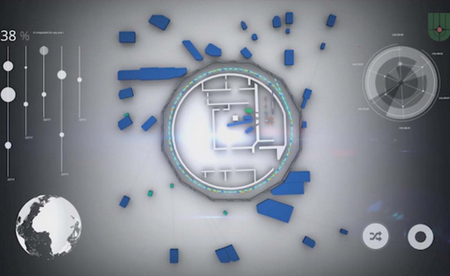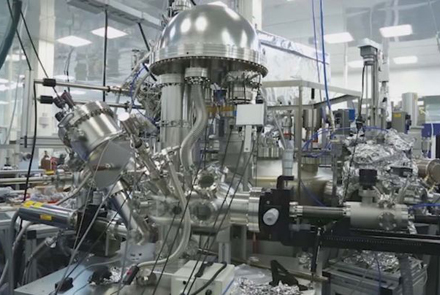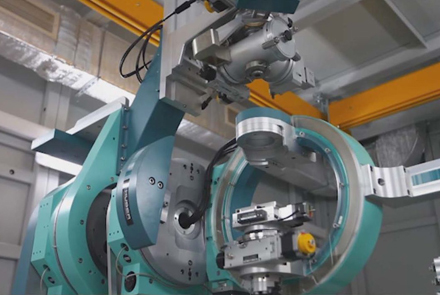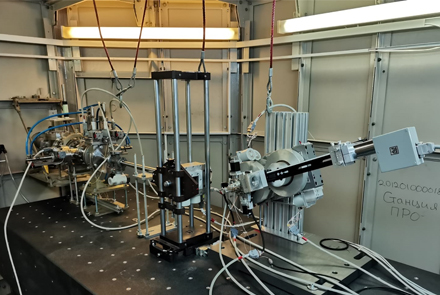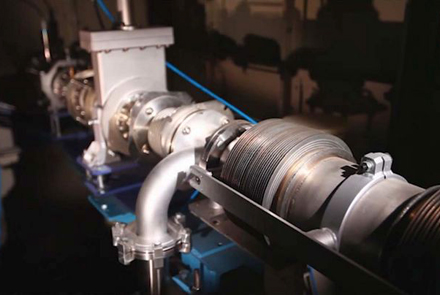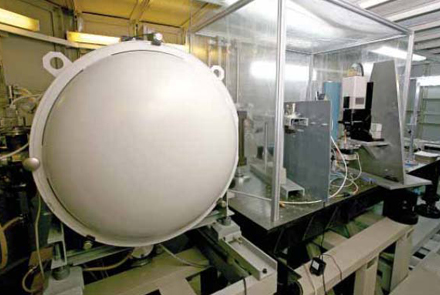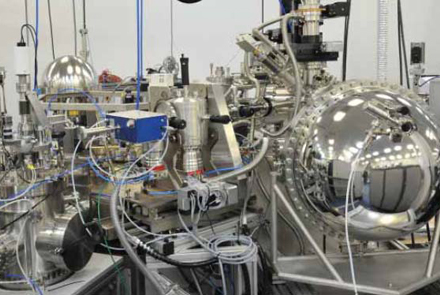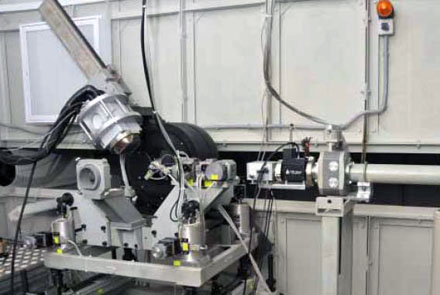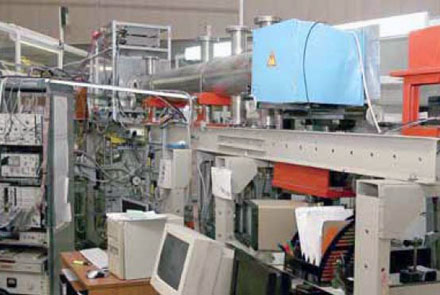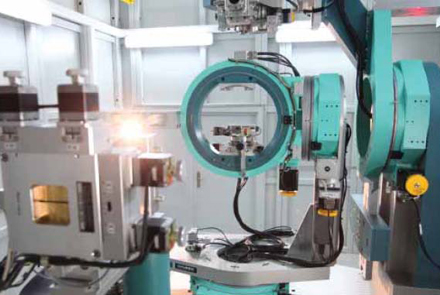|
Synchrotron radiation source
[an error occurred while processing this directive]
1. Design
The Kurchatov acceleration-storage complex (ASC) of specialized synchrotron radiation source (“KISI-Kurchatov”) includes three accelerator systems: a linear electron accelerator (LINAC) with an energy of up to 80 MeV, a small storage ring (SSR) with an energy of 450 MeV, and a large storage ring (LSR) for energy up to 2.5 GeV. The main source of synchrotron radiation (SR) is a large storage ring. Small storage ring serves for intermediate acceleration of electrons from 80 to 450 MeV and injection into a LSR; it is also a source of SR in vacuum ultraviolet and soft X-rays region. The ASC also includes electron transfer channels between accelerators, technological and engineering systems to ensure their operation.
Storage rings generate bright beams of electromagnetic radiation from infrared to hard X-rays in the wavelength range from 0.1 to 2000 Å. In order to obtain more intense photon fluxes, special emitters, so-called insertion devices (wigglers), are installed in the straight intervals of the LSR.
ASC in NRC “Kurchatov Institute” is the only specialized source of synchrotron radiation in former Soviet Union. ASC equipment was manufactured at the Budker Institute of Nuclear Physics SB RAS (BINP).
2. Linear accelerator(LINAC)
The LINAC consist of an electron gun, a beam injection channel with a focusing and correction system for electron beam, an accelerating structure, an HF power source, a waveguide path, and an accelerated beam transport channel from the LINAC to a small storage ring.
A diode gun with an electron energy of 40 keV and a current of ~ 4A per pulse with a duration of ~ 18 ns is used as an injector for the LINAC. At present, energy acceptance of a small storage ring is 1%, while electron energy spread at the output of linear accelerator at an average energy of 78–80 MeV is about 7%. Electron beam from the gun enters the input of the linear accelerator. Between electron gun and the entrance of accelerating complex magnetic correctors and two focusing lenses are placed. Magnetic corrector is used to adjust the beam center position relative to the axis of the beam. Focusing lenses set the diameter of the converging electron beam (~ 5–6 mm) in the center of the first accelerating gap. LINAC accelerating structure has 112 accelerating gaps.
After acceleration up to 80 MeV, the electron beam consists of about 50 microbunches formed by the accelerating HF field of the linear accelerator, following each other with 2.8 GHz frequency. The electron-optical channel (EOC-1) is used to transport electrons from a linear accelerator to a small storage ring. The beam released from the LINAC is indicated on two mesh probes and a Faraday cup placed in the EOC-1, by which the current (charge) and beam position are measured. Beam injection is carried out with a frequency of 1 Hz.
3. Small storage ring (SSR)
This storage ring is historically the first source of SR at the NRC “Kurchatov Institute”. It worked in this capacity from 1983 to 1990. In 1993, it was moved to building 348 and now is used as a booster synchrotron, providing electron injection into a large storage ring with an energy of 450MeV. The SSR has 4 SR output channels.
SSR is a ring with soft focusing of the electron beam, which is carried out by 4 bending 90-degree magnets. Two quadrupole lenses are used for additional focusing. Three vertical and four horizontal correctors are used for vertical orbit correction. Two pulsed septum magnets with a maximum field of up to 3T and deflecting plates are applied for electron inlet and outlet. To accelerate the electrons, a resonator with a 20 kV maximum voltage and 34.55 MHz frequency is used.
The rate of current increasing from the LINAC during injection is 15–20 mA/s. After the intended current has been set, the injection stops, the energy rises (a consistent increase in the field in the magnets, a change in the current in the lenses and correctors, an increase in the accelerating voltage across the resonator) to 450 MeV. Next, electrons are released into the electron-optical channel (EOC-2), leading to a large storage ring. Then the injection mode from the LINAC is set again. The entire injection cycle in the SSR takes 30–40 seconds.
4. Large storage ring (LSR)
The official opening of the Kurchatov specialized source of synchrotron radiation took place in 1999 and attended by Prime Minister of Russia Vladimir Putin.
The magnetic structure of the synchrotron is optimized in order to obtain maximum SR brightness from bending magnets and special insertion devices (ID) - wigglers. The structure consists of 6 mirror-symmetric superperiods, each containing an achromatic rotation — a section in which the horizontal path of the electron beam does not depend on the deviation of their energy from the calculated one. These areas are intended for installation of high-field wigglers. There are 12 three-meter free gaps in LSR structure. Three of them are occupied by electron intake devices, diagnostic equipment and accelerating resonators. Insertion devices can be placed in the rest free spaces. Storage ring structure contains 24 bending magnets, 72 quadrupole lenses, 24 sextupole lenses to compensate for chromatism, 48 horizontal and vertical orbit correctors. Each of the 24 bending magnets has a SR output channel.
Electrons are injected into the LSR during one circle with a shock through a previously accumulated electron beam and is carried out using a septum magnet with a field of 2T and two pulse generators, the load of which is the plate inside the vacuum chamber. In total, up to 75 electron clusters can be in orbit, with a minimum interval 5.5ns between them.
The vacuum chamber inside magnets and lenses is made of aluminum alloy, the pumping units and bellows are made of stainless steel. Over 60 magnetic discharge pumps with built-in titanium evaporators provide vacuum pumping. Working vacuum in LSR is better than 10-7Pa.
To accelerate the electrons and compensate energy loss due to radiation, there are 3 HF cavities in LSR operating at a frequency of 181 MHz with a maximum total voltage of 1.8 MV.
Storage ring is equipped with 24 pickup-stations for measuring electrons closed orbit, sensors for measuring the electron current, self-frequencies, and electron current distribution over bunches. There is an optical diagnostic beamline for determining the longitudinal and transverse dimensions of an electron bunch, and obtaining a TV image of the beam. All diagnostic information is available in the main console complex.
5. Insertion devices (ID)
On the LSR ring there is a superconducting wiggler SCW-1 with a maximum field of 7.5 T and a period of field change of 16.4 cm. At the request of SR users, the field is currently limited to 4T. In 2019, two more superconducting wigglers (SCW-2 and SCW-3) with a maximum field of 3T and a period of change of the field of 4.8 cm were manufactured at the BINP.
|

